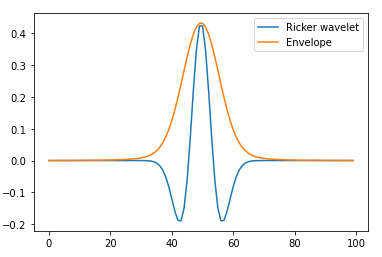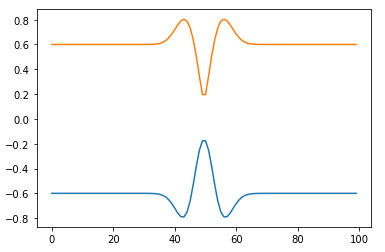This makes sense. A DC offset will shift the envelope just as demonstrated here. The analytic signal of a constant alone is the same constant since the Hilbert Transform will not pass a mean (or "DC offset"), and the process of transforming a signal to the analytic signal is linear. Therefore
$$f_a\{K+x(t)\} = f_a\{K\} + f_a{x(t)}$$
where here $f_a\{\}$ is the conversion to the analytic signal, $K$ is a DC offset, and $x(t)$ is the original signal.
This is described in further detail below:
Mathematically the analytic signal of $x(t)$ is given as:
$$x_a(t) = x(t) + j\hat x(t)$$
And the envelope is simply the magnitude of the analytic signal:
$$A(t) = |x_a(t)|$$
Where here in the OP's case, $x(t)$ is the Ricker Wavelet and $\hat x(t)$ is its Hilbert Transform. A key property of the Hilbert Transform is that it cannot pass DC, so any DC offset will directly shift the magnitude of the analytic signal directly.
In general given any arbitrary waveform that we convert to an analytic signal that will then be composed of magnitude and phase components, which we can express as:
$$x_a(t) = A(t)e^{j\phi(t)}$$
If we add a DC offset $K$ to $x(t)$, as $K+x(t)$, this will become a DC offset in $x_a(t)$ since $\hat x(t)$ will not be affected by $K$. Thus for real K as in the OP's case, the Analytic Signal of $x(t)+K$ will be $x_a(t)+K$ and
$$x_a(t)+K = (A(t)+K)e^{j\phi(t)}$$
More generally, for $K$ complex, the analytic signal will change both by the magnitude of $K$ and phase of $K$.
Removing the mean of the wavelet will avoid these latter two cases from occurring, but it is essentially forcing it to be the original Ricker wavelet.
For a completely intuitive view, consider the simple graphic below showing a general signal and it's envelope (which we can get from the absolute value of the analytic signal). Here we see a pulse that is modulated in amplitude and possibly phase, and the concept of it's envelope is quite clear that we simply follow the absolute value of the peaks. Now consider what would happen if you added a DC offset to this signal- the amplitude of the absolute value of the signal will shift accordingly as will it's envelope, by that same DC offset directly!





